实验6:开源控制器实践——RYU
实验目的
- 能够独立部署RYU控制器
- 能够理解RYU控制器实现软件定义的集线器原理
- 能够理解RYU控制器实现软件定义的交换机原理
二、实验环境
- 下载虚拟机软件Oracle VisualBox或VMware;
- 在虚拟机中安装Ubuntu 20.04 Desktop amd64,并完整安装Mininet;
三、实验要求
(一)基本要求
-
安装截图

-
查看网络拓扑
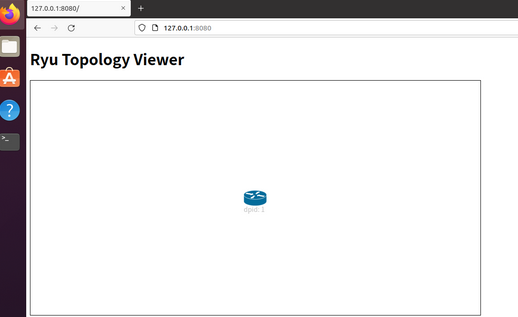
-
L2Switch.py文件
from ryu.base import app_manager
from ryu.controller import ofp_event
from ryu.controller.handler import MAIN_DISPATCHER
from ryu.controller.handler import set_ev_cls
from ryu.ofproto import ofproto_v1_0
class L2Switch(app_manager.RyuApp):
OFP_VERSIONS = [ofproto_v1_0.OFP_VERSION]
def __init__(self, *args, **kwargs):
super(L2Switch, self).__init__(*args, **kwargs)
@set_ev_cls(ofp_event.EventOFPPacketIn, MAIN_DISPATCHER)
def packet_in_handler(self, ev):
msg = ev.msg
dp = msg.datapath
ofp = dp.ofproto
ofp_parser = dp.ofproto_parser
actions = [ofp_parser.OFPActionOutput(ofp.OFPP_FLOOD)]
data = None
if msg.buffer_id == ofp.OFP_NO_BUFFER:
data = msg.data
out = ofp_parser.OFPPacketOut(
datapath=dp, buffer_id=msg.buffer_id, in_port=msg.in_port,
actions=actions, data = data)
dp.send_msg(out)
run L2Switch.py

- h1 ping h2:
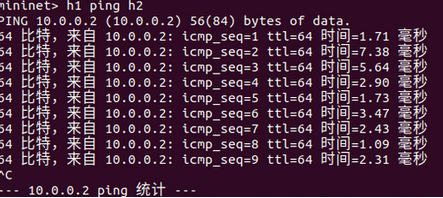
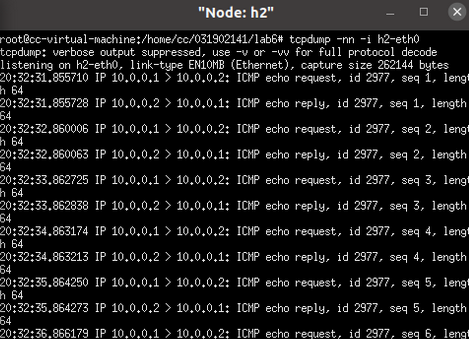
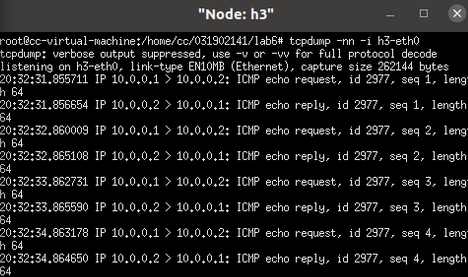
- h1 ping h3
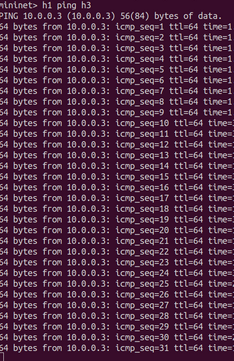


- 洪泛转发ICMP报文

看到没有流表 - pox的hub模块会看到流表
进阶要求
回答下列问题:
# Copyright (C) 2011 Nippon Telegraph and Telephone Corporation.
#
# Licensed under the Apache License, Version 2.0 (the "License");
# you may not use this file except in compliance with the License.
# You may obtain a copy of the License at
#
# http://www.apache.org/licenses/LICENSE-2.0
#
# Unless required by applicable law or agreed to in writing, software
# distributed under the License is distributed on an "AS IS" BASIS,
# WITHOUT WARRANTIES OR CONDITIONS OF ANY KIND, either express or
# implied.
# See the License for the specific language governing permissions and
# limitations under the License.
# 引入包
from ryu.base import app_manager
from ryu.controller import ofp_event
from ryu.controller.handler import CONFIG_DISPATCHER, MAIN_DISPATCHER
from ryu.controller.handler import set_ev_cls
from ryu.ofproto import ofproto_v1_3
from ryu.lib.packet import packet
from ryu.lib.packet import ethernet
from ryu.lib.packet import ether_types
class SimpleSwitch13(app_manager.RyuApp):
# 定义openflow版本
OFP_VERSIONS = [ofproto_v1_3.OFP_VERSION]
def __init__(self, *args, **kwargs):
super(SimpleSwitch13, self).__init__(*args, **kwargs)
# 定义保存mac地址到端口的一个映射
self.mac_to_port = {}
# 处理EventOFPSwitchFeatures事件
@set_ev_cls(ofp_event.EventOFPSwitchFeatures, CONFIG_DISPATCHER)
def switch_features_handler(self, ev):
datapath = ev.msg.datapath
ofproto = datapath.ofproto
parser = datapath.ofproto_parser
# install table-miss flow entry
#
# We specify NO BUFFER to max_len of the output action due to
# OVS bug. At this moment, if we specify a lesser number, e.g.,
# 128, OVS will send Packet-In with invalid buffer_id and
# truncated packet data. In that case, we cannot output packets
# correctly. The bug has been fixed in OVS v2.1.0.
match = parser.OFPMatch()#match:流表项匹配,OFPMatch():不匹配任何信息
actions = [parser.OFPActionOutput(ofproto.OFPP_CONTROLLER,
ofproto.OFPCML_NO_BUFFER)]
self.add_flow(datapath, 0, match, actions)#添加流表项
# 添加流表
def add_flow(self, datapath, priority, match, actions, buffer_id=None):
# 获取交换机信息
ofproto = datapath.ofproto
parser = datapath.ofproto_parser
# 对action进行包装
inst = [parser.OFPInstructionActions(ofproto.OFPIT_APPLY_ACTIONS,
actions)]
# 判断是否有buffer_id,生成mod对象
if buffer_id:
mod = parser.OFPFlowMod(datapath=datapath, buffer_id=buffer_id,
priority=priority, match=match,
instructions=inst)
else:
mod = parser.OFPFlowMod(datapath=datapath, priority=priority,
match=match, instructions=inst)
# 发送mod
datapath.send_msg(mod)
# 触发packet in事件,调用_packet_in_handler
@set_ev_cls(ofp_event.EventOFPPacketIn, MAIN_DISPATCHER)
def _packet_in_handler(self, ev):
# If you hit this you might want to increase
# the "miss_send_length" of your switch
if ev.msg.msg_len < ev.msg.total_len:
self.logger.debug("packet truncated: only %s of %s bytes",
ev.msg.msg_len, ev.msg.total_len)
# 获取包信息,交换机信息,协议等等
msg = ev.msg
datapath = msg.datapath
ofproto = datapath.ofproto
parser = datapath.ofproto_parser
in_port = msg.match['in_port']
pkt = packet.Packet(msg.data)
eth = pkt.get_protocols(ethernet.ethernet)[0]
# 忽略LLDP类型
if eth.ethertype == ether_types.ETH_TYPE_LLDP:
# ignore lldp packet
return
# 获取源端口和目的端口
dst = eth.dst
src = eth.src
dpid = format(datapath.id, "d").zfill(16)
self.mac_to_port.setdefault(dpid, {})
self.logger.info("packet in %s %s %s %s", dpid, src, dst, in_port)
# 学习包的源地址,绑定交换机上的入端口
# learn a mac address to avoid FLOOD next time.
self.mac_to_port[dpid][src] = in_port
# 查看是否已学习该目的mac地址
if dst in self.mac_to_port[dpid]:
out_port = self.mac_to_port[dpid][dst]
# 否则进行洪泛
else:
out_port = ofproto.OFPP_FLOOD
actions = [parser.OFPActionOutput(out_port)]
# 下发流表处理后续包,不再触发 packet in
# install a flow to avoid packet_in next time
if out_port != ofproto.OFPP_FLOOD:
match = parser.OFPMatch(in_port=in_port, eth_dst=dst, eth_src=src)
# verify if we have a valid buffer_id, if yes avoid to send both
# flow_mod & packet_out
if msg.buffer_id != ofproto.OFP_NO_BUFFER:
self.add_flow(datapath, 1, match, actions, msg.buffer_id)
return
else:
self.add_flow(datapath, 1, match, actions)
data = None
if msg.buffer_id == ofproto.OFP_NO_BUFFER:
data = msg.data
# 发送Packet_out数据包
out = parser.OFPPacketOut(datapath=datapath, buffer_id=msg.buffer_id,
in_port=in_port, actions=actions, data=data)
# 发送流表,带上交换机发来的数据包的信息
datapath.send_msg(out)
a) 代码当中的mac_to_port的作用是什么?
答:mac_to_port保存mac地址到交换机端口的映射。
b) simple_switch和simple_switch_13在dpid的输出上有何不同?
答:差别:simple_switch直接输出dpid,simple_switch_13会在dpid前端加上0将其填充至16位。
#simple_switch.py
dpid = datapath.id
self.mac_to_port.setdefault(dpid, {})
self.logger.info("packet in %s %s %s %s", dpid, src, dst, msg.in_port)
#simple_switch_13.py
dpid = format(datapath.id, "d").zfill(16)
self.mac_to_port.setdefault(dpid, {})
self.logger.info("packet in %s %s %s %s", dpid, src, dst, in_port)
c) 相比simple_switch,simple_switch_13增加的switch_feature_handler实现了什么功能?
答:实现交换机以特性应答消息响应特性请求
d) simple_switch_13是如何实现流规则下发的?
答:在接收到packetin事件后,首先获取包学习,交换机信息,以太网信息,协议信息等。如果以太网类型是LLDP类型,则不予处理。如果不是,则获取源端口目的端口,以及交换机id,先学习源地址对应的交换机的入端口,再查看是否已经学习目的mac地址,如果没有则进行洪泛转发。如果学习过该mac地址,则查看是否有buffer_id,如果有的话,则在添加流动作时加上buffer_id,向交换机发送流表。
e) switch_features_handler和_packet_in_handler两个事件在发送流规则的优先级上有何不同?
回答:switch_features_handler下发流表的优先级更高
(三)个人总结
- 实验难度:
本次实验基础部分难度较低,进阶部分难度稍高。
ryu的安装较为简单,且基础部分的实验操作与实验五差别不大,因此感觉不难。
而进阶部分由需要阅读源码,且需要对openflow协议有一定理解,难度较高,花费了不少时间。 - 实验中遇到的困难及解决办法
命令行没找对位置,运行L2Switch.py时试了半天才发现路径不对,最后改了路径成功了 - 个人感想
这次基本要求倒是中规中矩,没什么感想。而进阶要求难度不小,有些问题需要真正去阅读代码以及查一些资料相结合才能搞明白,花了不少时间,看来如何高效使用搜索引擎也是一门必修课,还有就是发现注释很重要。